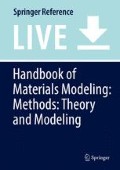Abstract
In order to speed up molecular simulations, coupled continuum-atomistic methods have been developed in which atomistic resolution is only retained in regions of interest with the rest of the model approximated as a continuum. In parallel, there have been efforts to extend the time scale accessible in molecular simulations by filtering out atomic vibrations and focusing on the more interesting dynamics associated with the formation and motion of defects. This article focuses on a current research trend to combine these two complementary approaches into a unified framework that can simultaneously span multiple length and time scales from the microscopic to the macroscopic. As a specific example, the combination of the spatial quasicontinuum (QC) method with the temporal hyperdynamics method to create “hyper-QC” is described.
References
Curtin WA, Miller RE (2003) Atomistic/continuum coupling methods in multi-scale materials modeling. Model Simul Mater Sci Eng 11:R33–R68
Dupuy LM, Tadmor EB, Miller RE, Phillips R (2005) Finite temperature quasicontinuum: molecular dynamics without all the atoms. Phys Rev Lett 95:060202
Germann TC, Kadau K (2008) Trillion-atom molecular dynamics becomes a reality. Int J Mod Phys C 19:1315–1319
Gnecco E, Bennewitz R, Gyalog T, Loppacher C, Bammerlin M, Meyer E, Güntherodt HJ (2000) Velocity dependence of atomic friction. Phys Rev Lett 84:1172–1175
Henkelman G, Jónsson H (2001) Long time scale kinetic Monte Carlo simulations without lattice approximation and predefined event table. J Chem Phys 115:9657–9666
Jaynes ET (1957a) Information theory and statistical mechanics. Part I. Phys Rev 106:620–630
Jaynes ET (1957b) Information theory and statistical mechanics. Part II. Phys Rev 108:171–190
Kim WK, Falk ML (2010) Accelerated molecular dynamics simulation of low-velocity frictional sliding. Model Simul Mater Sci Eng 18:034003
Kim WK, Tadmor EB (2017) Accelerated quasicontinuum: a practical perspective on hyper-QC with application to nanoindentation. Philos Mag 97:2284–2316
Kim WK, Luskin M, Perez D, Voter AF, Tadmor EB (2014) Hyper-QC: an accelerated finite-temperature quasicontinuum method using hyperdynamics. J Mech Phys Solids 63:94–112
Kirkwood JG (1935) Statistical mechanics of fluid mixtures. J Chem Phys 3:300–313
Knap J, Ortiz M (2001) An analysis of the quasicontinuum method. J Mech Phys Solids 49: 1899–1923
Kulkarni Y, Knap J, Ortiz M (2008) A variational approach to coarse graining of equilibrium and non-equilibrium atomistic description at finite temperature. J Mech Phys Solids 56:1417–1449
Laio A, Parrinello M (2002) Escaping free-energy minima. Proc Natl Acad Sci USA 99: 12562–12566
LeSar R, Najafabadi R, Srolovitz D (1989) Finite-temperature defect properties from free-energy minimization. Phys Rev Lett 63:624–627
Li J, Sarkar S, Cox WT, Lenosky TJ, Bitzek E, Wang Y (2011) Diffusive molecular dynamics and its application to nanoindentation and sintering. Phys Rev B 84:054103
Miller RE, Tadmor EB (2002) The quasicontinuum method: overview, applications, and current directions. J Comput Aided Mater Des 9:203–239
Miller RE, Tadmor EB (2009) A unified framework and performance benchmark of fourteen multiscale atomistic/continuum coupling methods. Model Simul Mater Sci Eng 17:053001
Miron RA, Fichthorn KA (2003) Accelerated molecular dynamics with the bond-boost method. J Chem Phys 119:6210–6216
Ponga M, Ortiz M, Ariza M (2015) Finite-temperature non-equilibrium quasi-continuum analysis of nanovoid growth in copper at low and high strain rates. Mech Mater 90:253–267
Ponga M, Ramabathiran AA, Bhattacharya K, Ortiz M (2016) Dynamic behavior of nano-voids in magnesium under hydrostatic tensile stress. Model Simul Mater Sci Eng 24:065003
Shenoy VB, Miller R, Tadmor EB, Rodney D, Phillips R, Ortiz M (1999) An adaptive finite element approach to atomic-scale mechanics: the quasicontinuum method. J Mech Phys Solids 47: 611–642
Sørensen MR, Voter AF (2000) Temperature-accelerated dynamics for simulation of infrequent events. J Chem Phys 112:9599–9606
Tadmor EB, Miller RE (2011) Modeling materials: continuum, atomistic and multiscale techniques. Cambridge University Press, Cambridge
Tadmor EB, Ortiz M, Phillips R (1996) Quasicontinuum analysis of defects in solids. Philos Mag A 73:1529–1563
Tadmor EB, Smith GS, Bernstein N, Kaxiras E (1999) Mixed finite element and atomistic formulation for complex cystals. Phys Rev B 59:235–245
Tadmor EB, Legoll F, Kim WK, Dupuy LM, Miller RE (2013) Finite-temperature quasi-continuum. Appl Mech Rev 65:010803
Tomlinson GA (1929) A molecular theory of friction. Philos Mag 7:905–939
Vanden-Eijnden E, Tal FA (2005) Transition state theory: variational formulation, dynamical corrections, and error estimates. J Chem Phys 123:184103
Venturini G, Wang K, Romero I, Ariza MP, Ortiz M (2014) Atomistic long-term simulation of heat and mass transport. J Mech Phys Solids 73:242–268
Voter AF (1997) A method for accelerating the molecular dynamics simulation of infrequent events. J Chem Phys 106:4665–4667
Voter AF (1998) Parallel replica method for dynamics of infrequent events. Phys Rev B 57: 13985–13988
Voter AF (2005) Introduction to the Kinetic Monte Carlo method. In: Sickafus KE, Kotomin EA (eds) Radition effects in solids. Springer, NATO Publishing Unit, Dordrecht
Zhou XW, Johnson RA, Wadley HNG (2004) Misfit-energy-increasing dislocations in vapor-deposited CoFe/NiFe multilayers. Phys Rev B 69:144113
Acknowledgements
WKK and EBT were supported in part by the National Science Foundation (NSF) through a collaborative research grant under Award Numbers CMMI-1463038 and CMMI-1462807, respectively.
Author information
Authors and Affiliations
Corresponding author
Editor information
Editors and Affiliations
Section Editor information
Rights and permissions
Copyright information
© 2018 Springer International Publishing AG, part of Springer Nature
About this entry
Cite this entry
Kim, W.K., Tadmor, E.B. (2018). Temporal Acceleration in Coupled Continuum-Atomistic Methods. In: Andreoni, W., Yip, S. (eds) Handbook of Materials Modeling . Springer, Cham. https://doi.org/10.1007/978-3-319-42913-7_26-1
Download citation
DOI: https://doi.org/10.1007/978-3-319-42913-7_26-1
Published:
Publisher Name: Springer, Cham
Print ISBN: 978-3-319-42913-7
Online ISBN: 978-3-319-42913-7
eBook Packages: Springer Reference Physics and AstronomyReference Module Physical and Materials ScienceReference Module Chemistry, Materials and Physics

